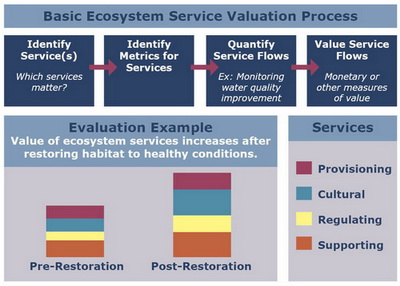- Habitat Home
- About Us
- Our Work
- About Habitat
- Funding Opportunities
- Our Partners
- News & Multimedia
- Publications & Resources

|
 |
Estimating the Value of Nature’s Benefits
Why is ecosystem service valuation so important in the first place? The end goal of ecosystem service valuation is to demonstrate how changes in ecosystem services affect human well-being, so that policy and management decisions can better account for human and ecosystem needs. The valuation process can include cost-benefit analyses or other methods to assess the impact of ecosystem services on society.
Steps of the Valuation Process

Market vs. Non-market Values for Habitat
In economics, there is a distinction between market and non-market goods and services. Market goods and services in a free market economy are sold for prices that reflect a balance between how much it costs to produce them and what people are willing to pay. Some environmental goods and services, such as fish and oysters, are traded in markets, thus, their value can be directly observed (www.greenfacts.org).
On the other hand, a non-market good or service is something that is not bought or sold directly. Therefore, a non-market good does not have an observable monetary value. Examples of this include beach visits, wildlife viewing, or snorkeling at a coral reef.
Valuing Nature Is Not Easy
Many habitats are hard to value—they have inherent worth because they are important to us as a society even though we might not benefit from them directly. Examples include the existence of endangered species or the continued presence of deep-sea coral reefs.
Habitat values are typically described in terms of non-use values, including bequest and existence values, and can have significant policy relevance. Ecosystem service valuation methods can be used to estimate the “non-use” or “indirect” use values associated with particular ecological characteristics.
Typical Valuation Methods
There are several methods used to estimate monetary value for ecosystem services, including: market price, travel cost, hedonic pricing, contingent valuation, and contingent choice experiment methods. Other approaches include benefit or value transfers and bio-economic modeling. Social scientists continue to make improvements on these types of valuation methods.
The estimated values obtained from ecosystem service valuation studies are helpful for policy analysis and decision making. The results of these studies are typical components of benefit cost analyses, regulatory actions, and damage assessments. The aim is to better inform decision makers of the trade-offs between environmental protection and resource use.



